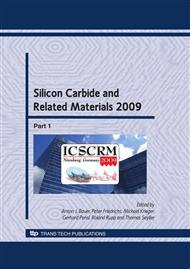p.367
p.371
p.375
p.379
p.383
p.387
p.391
p.395
p.399
TEM and LTPL Investigations of 3C-SiC Layers Grown by LPE on (100) and (111) 3C-SiC Seeds
Abstract:
In the present work the defects appearing in layers grown by liquid phase epitaxy on different substrates are compared. The used seeds were (i) 3C-SiC with (111) orientation, grown heteroepitaxially on (0001) 4H-SiC or 6H-SiC substrates by continuous feed physical vapour transport process and the vapour-liquid-solid mechanism, respectively, and (ii) 3C-SiC wafer with (100) orientation from HOYA. The structural and optical investigation showed that (i) on the (111) substrates, due to the appearance of silicon and 6H-SiC inclusions, a layer which consisted of a sequence of long period polytypes was formed. The dominant polytype formed was 21R-SiC, which after successive transformation to 39R- and 57R- SiC led to the formation of 6H-SiC on the top of the layer. (ii) On the (100) substrates, a 3C-SiC layer with comparatively uniform defect density was formed. The main defects were stacking faults and their density was reducing during the process.
Info:
Periodical:
Pages:
383-386
Citation:
Online since:
April 2010
Price:
Сopyright:
© 2010 Trans Tech Publications Ltd. All Rights Reserved
Share:
Citation:


